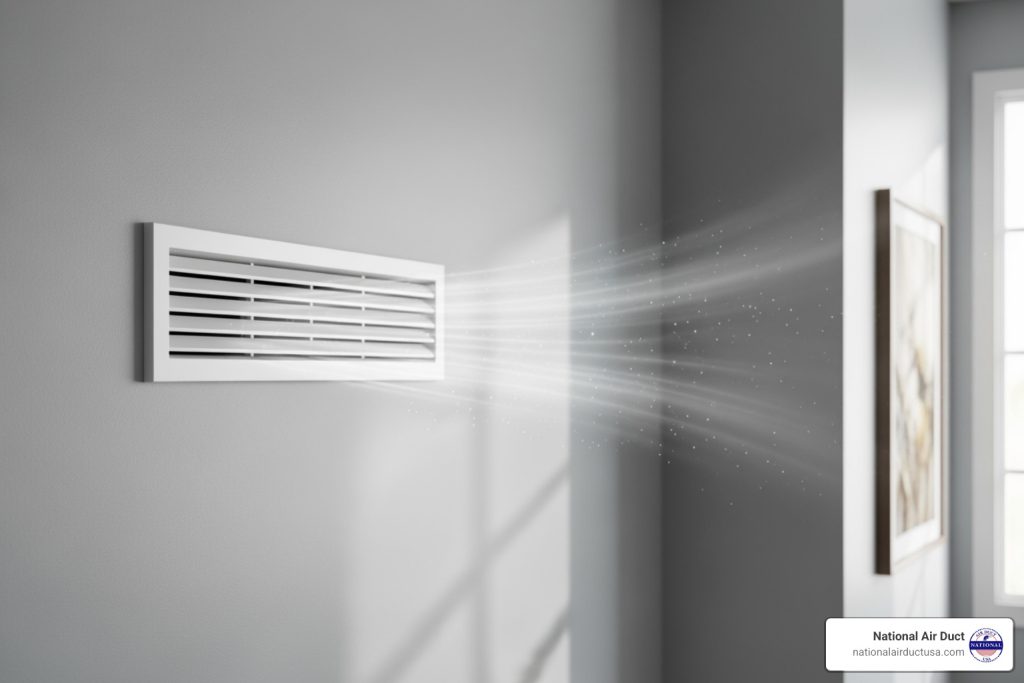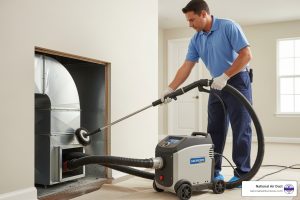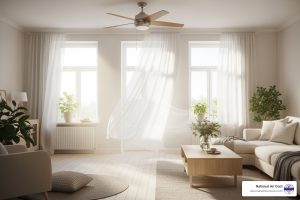Why Clean Ventilation Systems Are Critical for Your Home
A clean ventilation system is essential for healthy indoor air, energy efficiency, and protecting your family. Your heating and cooling system acts as the lungs of your home, but indoor air can be two to five times more polluted than outdoor air, according to the National Air Duct Cleaners Association (NADCA). This air recirculates 5-7 times daily, distributing contaminants throughout your home.
Key Benefits of a Clean System:
- Better Air Quality: Removes dust, allergens, and pollutants.
- Energy Savings: Uses 5-15% less energy, reducing utility bills.
- Health Protection: Reduces respiratory issues and allergy triggers.
- System Longevity: Prevents costly repairs and extends HVAC lifespan.
Signs You Need Cleaning:
- Visible dust from vents
- Musty or stale odors
- Increased allergy symptoms
- Higher energy bills
- After construction or renovation
Professional cleaning significantly improves indoor air quality and helps your system work more efficiently, saving you money.
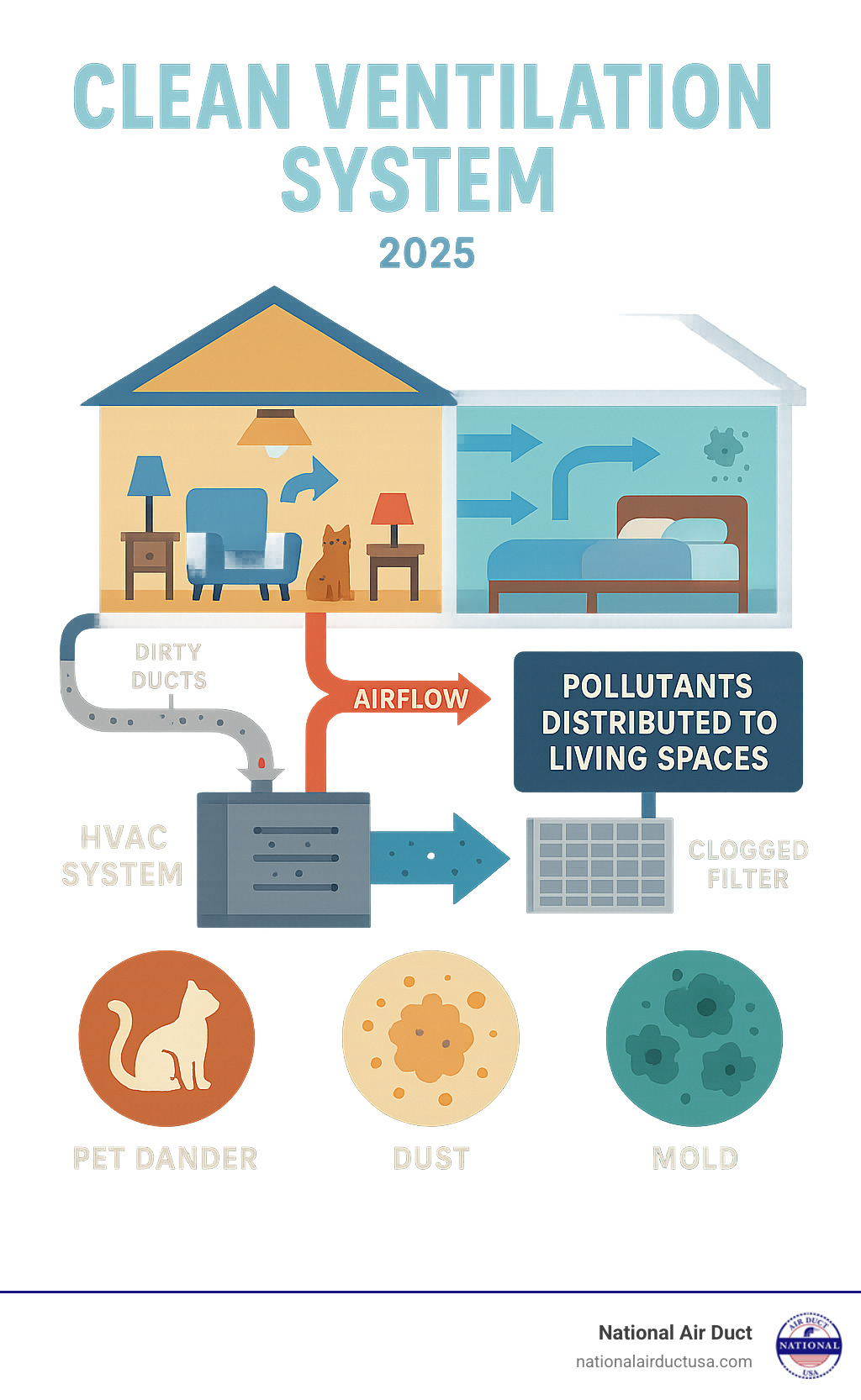
Why a Clean Ventilation System is Non-Negotiable
The EPA reports that indoor air can be two to five times more polluted than outdoor air, and since we spend about 90% of our time indoors, the quality of that air is critical. Your home’s ventilation system circulates this air five to seven times daily. When dirty, it spreads dust, allergens, and other contaminants with each cycle. A clean ventilation system is crucial for your family’s health, your energy bills, and the longevity of your HVAC system.
The Importance of a Clean Ventilation System for Health and Home
A contaminated ventilation system circulates microscopic troublemakers like dust mites, pet dander, mold spores, and bacteria. This directly impacts your family’s well-being:
- Allergy Relief: Professional cleaning removes trapped allergens, reducing sneezing, watery eyes, and congestion.
- Fewer Asthma Triggers: Removing irritants from the ductwork can significantly reduce the risk of asthma attacks.
- Odor Elimination: A deep cleaning removes the source of persistent musty smells from mold or debris.
- Improved Wellness: Many homeowners report reduced respiratory irritation, fewer headaches, and less fatigue after a cleaning. In fact, improving ventilation can reduce airborne virus particles according to the CDC.
Boosting HVAC Efficiency and Saving Money
A clean ventilation system also offers significant financial benefits. When ducts are clogged, your HVAC system works harder, leading to restricted airways and higher energy consumption. Professional cleaning can lead to lower energy consumption by 5-15%, resulting in lower utility bills.
This reduced strain on HVAC components also means an extended system life and fewer expensive repairs. Key components like the coils and blower assembly benefit most. For more details, see our pages on Coil Cleaning and Blower Cleaning.
Telltale Signs Your Air Ducts Need Cleaning
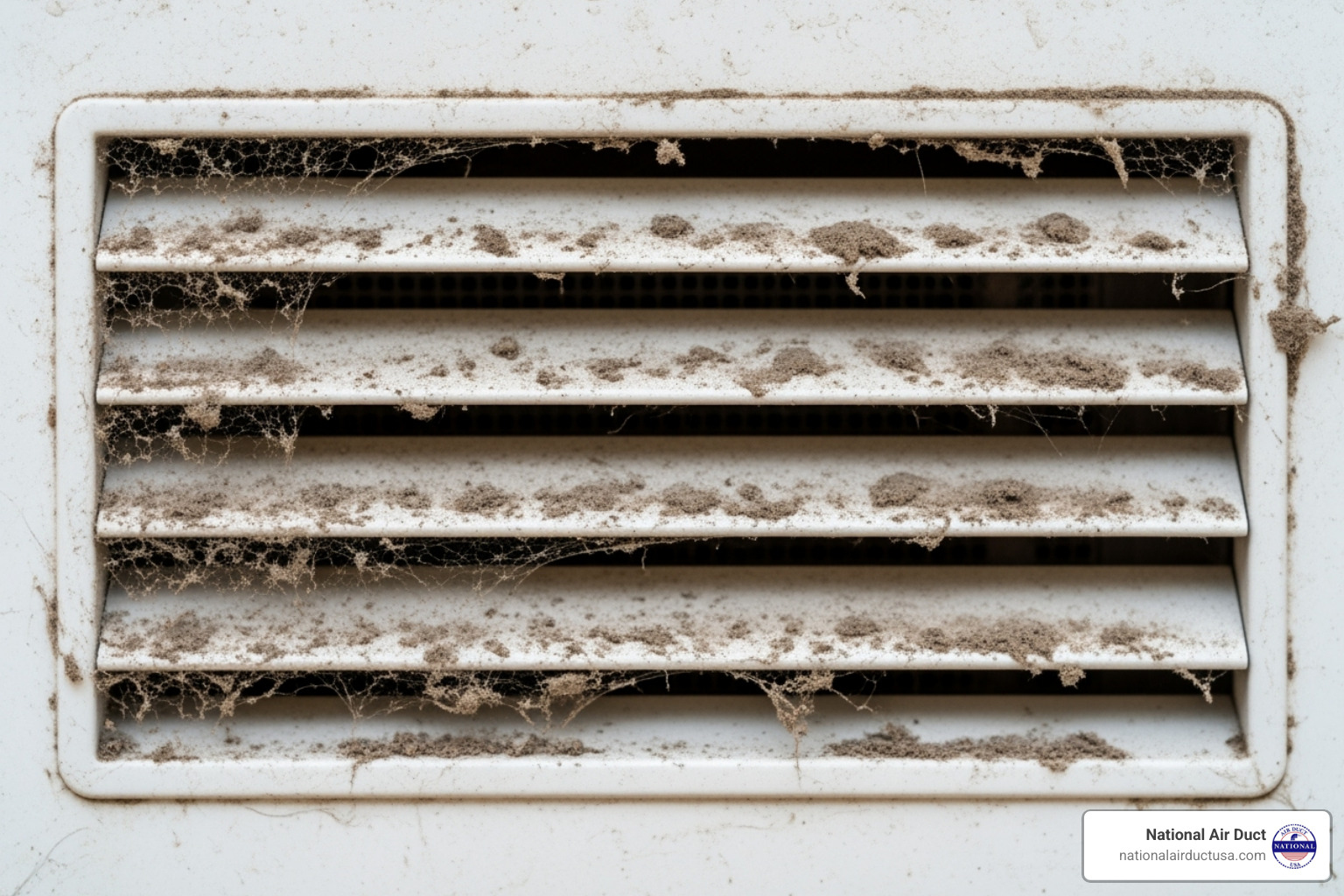
Your home provides clear signals when your ventilation system needs attention. By recognizing these signs, you can address problems before they escalate. Here’s what to look for to maintain a clean ventilation system.
Visible Clues You Can’t Ignore
- Dust Plumes from Vents: If you see puffs of dust when your system turns on, it’s a clear sign of heavy buildup.
- Debris in Ductwork: Visible dust, pet hair, or lint inside your vents indicates a larger problem deeper in the system.
- Dark Filtration Marks: Dingy streaks on walls or ceilings around vents are caused by dirty air escaping through gaps.
- Insect or Rodent Droppings: Evidence of pests in or near vents means your ductwork may be contaminated and requires professional cleaning.
- Visible Mold Growth: Fuzzy or discolored patches on or in your vents are a serious health concern that needs immediate, professional attention.
Invisible Warnings: Listen to Your Body and Your Home
- Unexplained Allergy or Asthma Flare-ups: If symptoms are worse indoors, your air quality is likely the culprit.
- Persistent Stale or Musty Smells: Odors you can’t eliminate often originate from mold or debris deep within the ductwork.
- Unusually High Utility Bills: A sudden spike in energy costs can mean your HVAC system is straining to push air through clogged ducts.
- Noisy Airflow from Vents: Whistling or rattling sounds often indicate blockages that are putting a strain on your system.
- Recent Construction or Renovation: Building projects create fine dust that settles in ductwork, making a post-project cleaning essential.
DIY Vent Maintenance vs. Professional Air Duct Cleaning
Maintaining a clean ventilation system involves both simple DIY tasks and comprehensive professional services. While regular homeowner maintenance is beneficial, it cannot replace a deep cleaning performed with specialized equipment. Understanding the difference is key to keeping your system in optimal condition.
Think of it like car care: you handle the oil checks and filter changes, but a professional addresses complex engine work. The same applies to your HVAC system.
| Task Category | DIY Maintenance | Professional Cleaning |
|---|---|---|
| Scope | Vent covers, filters, visible areas | Entire ductwork system, HVAC components |
| Tools Needed | Basic household items, vacuum | High-powered vacuums, specialized brushes, HEPA equipment |
| Effectiveness | Surface-level cleaning | Deep, comprehensive cleaning |
| Cost | Under $50 in supplies | $300-$800 depending on home size |
| When Appropriate | Regular maintenance | Significant contamination, health issues, system problems |
DIY Maintenance for a Cleaner Ventilation System
Regular DIY tasks can significantly improve your system’s performance between professional cleanings:
- Clean Vent Covers: Regularly wash register covers with warm, soapy water to remove collected dust.
- Vacuum Register Openings: Use a vacuum to clear any visible debris near the surface of the vent openings.
- Change HVAC Filters Regularly: This is the most critical task. Replace filters every 1-3 months to prevent debris from entering your ductwork.
- Keep Vents Unobstructed: Ensure furniture and drapes do not block airflow, which forces your system to work harder.
- Dust and Vacuum Regularly: Frequent cleaning reduces the amount of dust available to be pulled into your system.
When to Absolutely Call a Professional
Certain situations require professional expertise and equipment. Attempting to DIY these issues can be ineffective or even hazardous.
- Substantial Mold Growth: Mold requires professional remediation to prevent spores from spreading throughout your home.
- Pest or Rodent Infestation: Professionals can safely remove contamination and sanitize the system.
- After Fire or Water Damage: Specialized techniques are needed to remove soot, smoke residue, or moisture.
- Post-Construction or Renovation: Professional equipment is necessary to remove the heavy volume of fine dust and debris.
- Occupants with Severe Allergies or Respiratory Illness: Only a thorough, professional cleaning can achieve the air quality needed for sensitive individuals.
For a comprehensive cleaning of your entire system, explore our Residential Air Duct Cleaning services. Our NADCA-certified technicians have the training and equipment to restore your clean ventilation system.
Why is a clean ventilation system important for indoor air quality and HVAC efficiency?
Your home’s HVAC system acts as its lungs, circulating air 5-7 times per day. Since The EPA reports that indoor air can be two to five times more polluted than outdoor air, a dirty system continuously spreads contaminants like dust and allergens. A clean ventilation system is vital for creating a healthier living environment and ensuring your HVAC system runs efficiently.
The Importance of a Clean Ventilation System for Health and Home
A dirty ventilation system can negatively impact your family’s health. Professional cleaning provides:
- Allergy Relief: By removing dust mites, pet dander, and pollen from ductwork, cleaning reduces common allergy symptoms.
- Fewer Asthma Triggers: Eliminating airborne irritants like mold spores and dust makes the home safer for those with asthma.
- Odor Elimination: Deep cleaning removes the source of musty smells caused by mold or accumulated grime.
- Improved Well-being: Clean air contributes to reduced respiratory irritation, fewer headaches, and less fatigue. As the CDC notes, improving ventilation can reduce airborne virus particles.
Boosting HVAC Efficiency and Saving Money
A clean system is an efficient system. Clogged ducts cause restricted airflow, forcing your HVAC unit to work harder and waste energy. Key financial benefits include:
- Lower Energy Bills: According to the Department of Energy, a clean system can lower energy consumption by 5-15%.
- Reduced Strain on HVAC Components: Less strain means fewer breakdowns and a longer lifespan for your equipment.
- Extended System Life: A well-maintained system can delay the need for an expensive replacement.
Proper maintenance of components like coils and blowers is also essential. Learn more about our specialized coil cleaning and blower cleaning services.
Telltale Signs Your Air Ducts Need Cleaning
Your home often signals when its ventilation system needs cleaning. Recognizing these signs helps you maintain a clean ventilation system and prevent larger issues. Here are the key visible and invisible warnings to watch for.
Visible Clues You Can’t Ignore
- Dust Plumes from Vents: Puffs of dust appearing when the system starts indicate significant internal buildup.
- Debris in Ductwork: If you can see clumps of dust, pet hair, or lint by looking into a vent, the entire system needs cleaning.
- Dark Filtration Marks Around Vents: Dark streaks on walls or ceilings around registers show that dirty air is escaping.
- Insect or Rodent Droppings: Any sign of pests near vents is a serious red flag that requires professional sanitation.
- Visible Mold Growth: Fuzzy or discolored patches in or on vents signal a moisture problem and a health hazard that needs immediate professional attention.
Invisible Warnings: Listen to Your Body and Your Home
- Unexplained Allergy or Asthma Flare-ups: If symptoms worsen indoors, your air system is likely circulating allergens.
- Persistent Stale or Musty Smells: Lingering odors often point to mold, mildew, or bacteria deep within the ductwork.
- Unusually High Utility Bills: An increase in energy costs can mean your system is working harder to overcome restricted airflow from dirty ducts.
- Noisy Airflow from Vents: Whistling or rattling sounds can indicate blockages or strain on the system.
- Recent Renovations or Construction: Fine debris from construction projects easily enters ductwork and requires professional removal for a truly clean ventilation system.
DIY Vent Maintenance vs. Professional Air Duct Cleaning
Maintaining a clean ventilation system involves a combination of DIY upkeep and professional services. While regular home maintenance is important, it doesn’t replace the deep, comprehensive cleaning that professionals provide with specialized equipment.
| Task Category | DIY Maintenance | Professional Cleaning |
|---|---|---|
| Tools Needed | Basic household items (screwdriver, vacuum, microfiber cloths) | Specialized equipment (HEPA vacuums, agitation tools, inspection cameras) |
| Scope | Surface cleaning, filter changes, visible areas only | Complete system cleaning, deep ductwork, HVAC components |
| Effectiveness | Good for maintenance between professional cleanings | Comprehensive contamination removal |
| When Appropriate | Regular upkeep, minor dust buildup | Mold growth, pest infestation, post-construction, health concerns |
DIY Maintenance for a Cleaner Ventilation System
These simple tasks help maintain air quality between professional cleanings:
- Cleaning Vent Covers: Wash register covers with soap and water every few months.
- Vacuuming Register Openings: Use a vacuum attachment to remove surface-level dust from vent openings.
- Changing HVAC Filters Regularly: Replace filters every 1-3 months. This is the most effective way to prevent debris from entering your ducts.
- Keeping Vents Unobstructed: Ensure furniture and curtains don’t block airflow.
- Dusting and Vacuuming Your Home: Regular cleaning reduces the amount of dust that can be pulled into your system.
When to Absolutely Call a Professional
Some situations are beyond the scope of DIY and require professional intervention to avoid making problems worse:
- Substantial Mold Growth: Professionals have the tools and training to safely remediate mold without spreading spores.
- Pest or Rodent Infestation: Proper cleanup and sanitation are required to address the health hazards from pests.
- After Fire or Water Damage: Specialized cleaning is needed to handle smoke residue and moisture-related contamination.
- Post-Construction or Major Renovation: The fine, heavy dust from construction requires professional-grade equipment to remove.
- Occupants with Severe Allergies or Respiratory Illness: Professional cleaning is essential to achieve the high level of air quality needed for health and comfort.
For a deep clean that restores your entire system, our Residential Air Duct Cleaning services provide a comprehensive solution for a truly clean ventilation system.
The Professional Clean Ventilation System Process: What to Expect
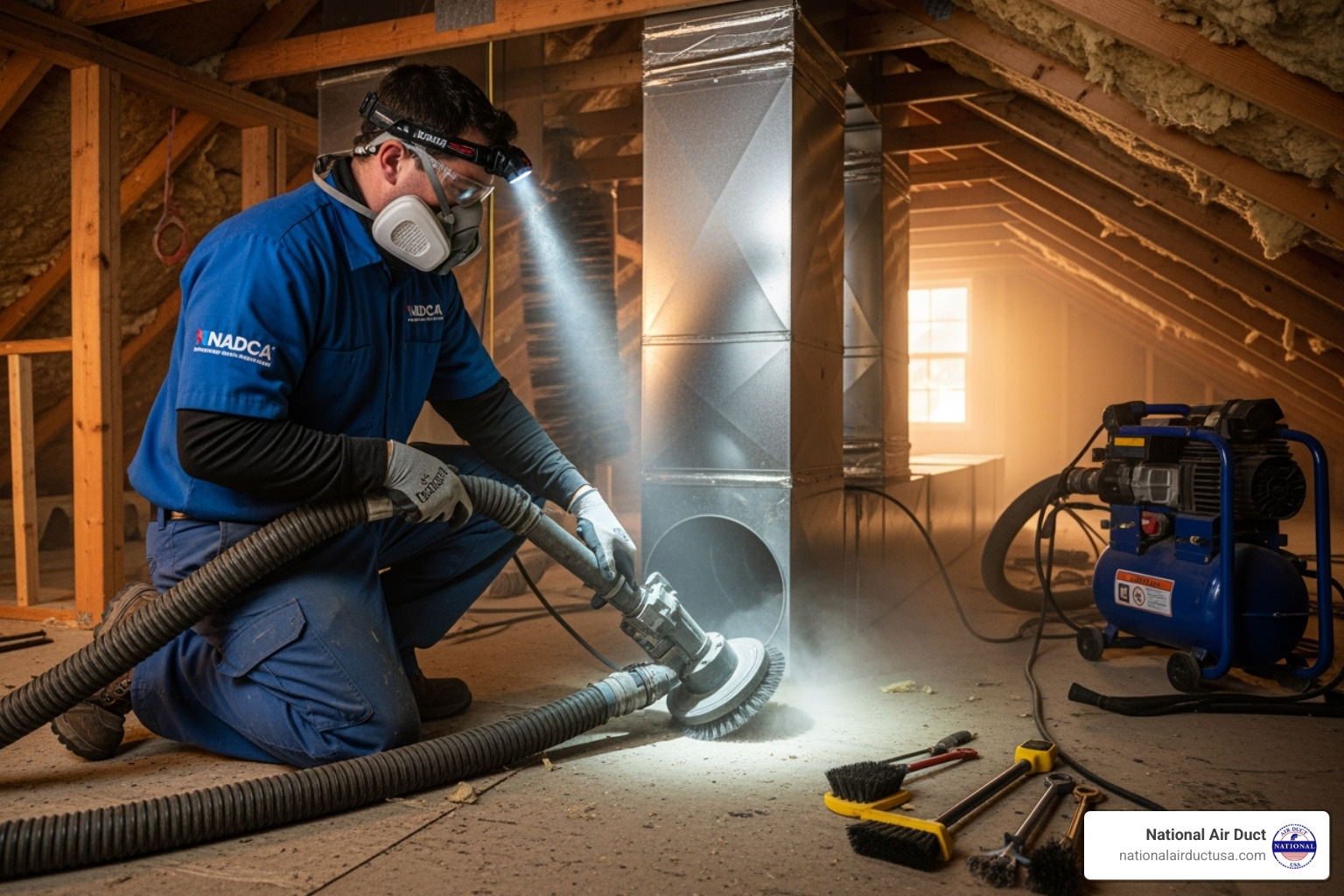
When you hire professionals to achieve a clean ventilation system, you are investing in a comprehensive process that cleans your entire HVAC system, not just the ducts. We follow the NADCA (National Air Duct Cleaners Association) standard of “source removal,” which uses powerful agitation tools to dislodge contaminants and high-powered vacuums to extract them from your home.
Step 1: Thorough System Inspection
Our NADCA-certified technicians begin with a detailed inspection to assess your system’s condition and plan the cleaning.
- Visual Inspection: We check for dust buildup, mold, pest activity, and damage.
- Access Points: We identify the best points to access the ductwork, creating new, professionally sealed holes only when necessary.
- Contaminant ID: We determine the type of debris (e.g., dust, construction debris) to select the best cleaning method.
- Component Assessment: We inspect the furnace, air handler, and coils to get a complete picture of your system’s health.
- Asbestos Check: In homes built before 1980, we check for asbestos-containing materials and advise on proper protocols if found.
Step 2: The Cleaning Process
We establish negative pressure with our powerful vacuums to ensure all dislodged debris is captured and removed from your home.
- High-Powered Vacuums: Truck-mounted or portable HEPA-filter vacuums create strong suction, preventing contaminants from re-entering your air.
- Agitation Tools: We use specialized brushes, air whips, and compressed air nozzles to scrub and blast debris from all interior duct surfaces.
- Complete Duct Cleaning: We thoroughly clean both the supply ducts (delivering clean air) and return ducts (pulling air back to the unit).
- Registers and Grilles: All vent covers are removed, cleaned, and disinfected before reinstallation.
- Optional Disinfecting: For systems with mold or bacteria, we can apply an EPA-registered antimicrobial chemical. Learn more about Disinfecting Air Ducts.
Step 3: Comprehensive Component Cleaning
A truly clean ventilation system includes all its parts. We clean the critical components of your HVAC unit to ensure optimal performance.
- Air Handler & Blower Motor: We clean the housing and blower assembly, as buildup here severely restricts airflow and efficiency.
- Evaporator Coils & Drain Pan: Cleaning these parts prevents mold growth and improves cooling efficiency.
- Heat Exchanger: We inspect and clean this component in furnaces for safety and efficiency.
- Air Filter Housing: We clean the area around your filter to ensure it works effectively.
For an extra layer of air purification, consider UV Lights Installation inside your system to neutralize airborne pathogens.
How to Keep Your Ventilation System Cleaner for Longer
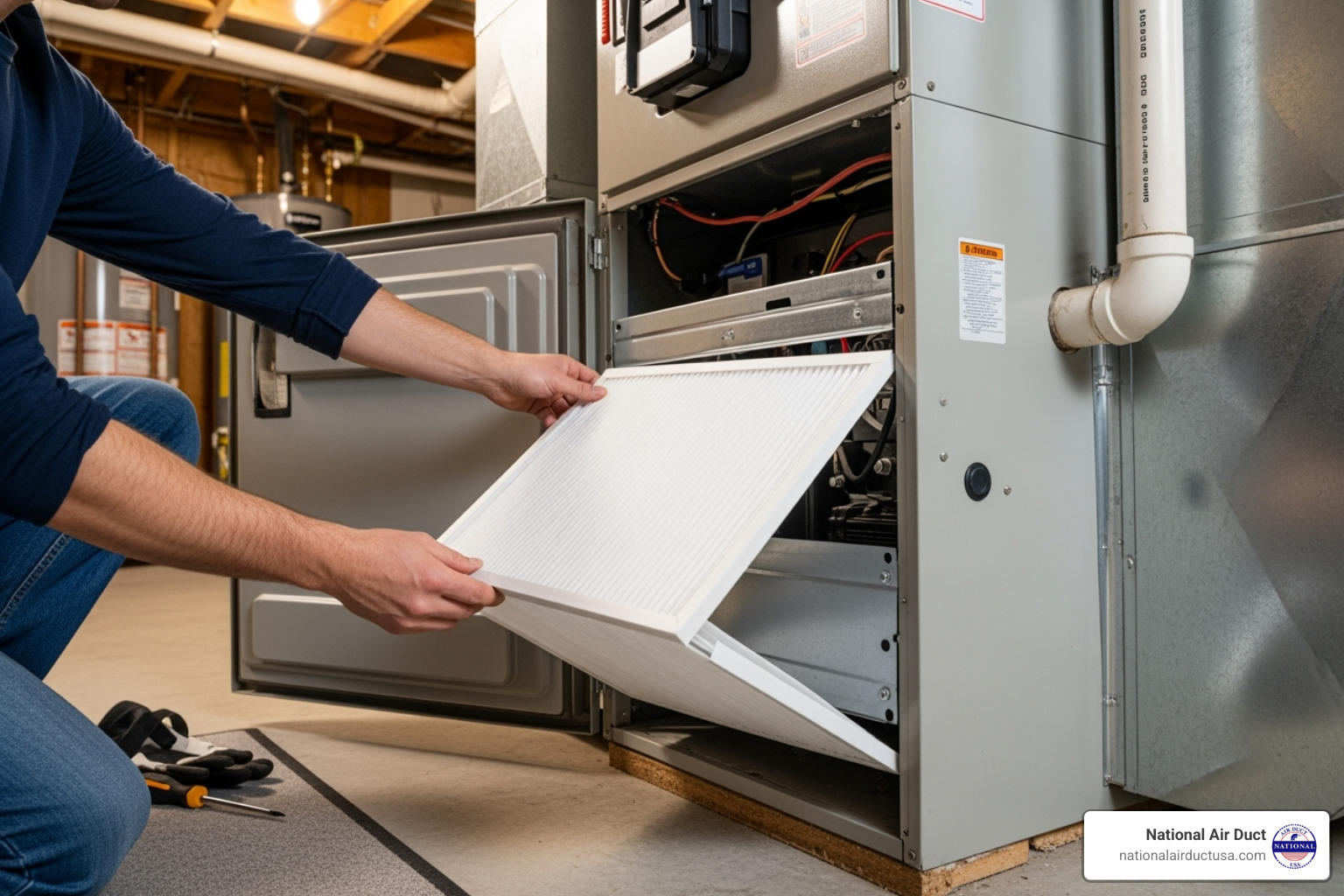
After a professional cleaning, ongoing maintenance is key to preserving the benefits of a clean ventilation system. Simple, regular habits can keep your system running efficiently and your indoor air quality high for years to come.
The Crucial Role of Air Filters
Your HVAC air filter is the first line of defense against airborne contaminants. Choosing the right one and changing it regularly is critical.
- Understand MERV Ratings: MERV (Minimum Efficiency Reporting Value) indicates a filter’s effectiveness. A MERV 8-11 filter is ideal for most homes, balancing filtration with airflow.
- Change Filters Every 1-3 Months: This is the most important rule. A clogged filter restricts airflow, increases energy bills, and allows debris to enter your freshly cleaned ducts.
- Prevent Debris Buildup: Regular filter changes protect your system’s internal components from dust and dirt, preventing premature wear.
Proactive Home Maintenance Habits
Your daily habits directly impact your home’s air quality and the cleanliness of your ventilation system.
- Regular Dusting and Vacuuming: Use a damp cloth for dusting and a vacuum with a HEPA filter to effectively remove particles from your home before they enter the vents.
- Use Doormats: Trap dirt and debris at the door to prevent it from being tracked inside and becoming airborne.
- Seal Duct Leaks: Leaky ducts waste energy and pull in dirty air from attics or crawl spaces. Have a professional inspect for leaks if you notice high bills or uneven temperatures.
- Control Indoor Humidity: Keep humidity between 30-50% to prevent mold and mildew growth in your ductwork. Use dehumidifiers or your HVAC system’s features.
- Schedule Annual Dryer Vent Cleaning: Lint buildup in dryer vents is a leading cause of house fires. Annual cleaning is a critical safety measure.
- Keep Outdoor Units Clean: Ensure your outdoor condenser unit is free of leaves and debris to maintain system efficiency.
Conclusion
We’ve explored why a clean ventilation system is essential for your family’s health, your home’s efficiency, and your budget. Clean ducts reduce allergens, eliminate odors, lower energy bills, and extend the life of your HVAC system.
We’ve also identified the key signs that your ducts need cleaning and clarified the difference between simple DIY maintenance and necessary professional services for issues like mold or post-construction cleanup.
Your HVAC system is the lungs of your home, and it deserves professional care. A truly clean ventilation system requires the expertise and specialized equipment of NADCA-certified technicians.
At National Air Duct USA, we provide NADCA-certified air duct and dryer vent cleaning services in New York. We are dedicated to improving indoor air quality, boosting energy efficiency, and preventing fires for our residential clients.
Ready to breathe cleaner air in a healthier, more efficient home? Explore our professional cleaning services and find the difference a truly clean system can make.

